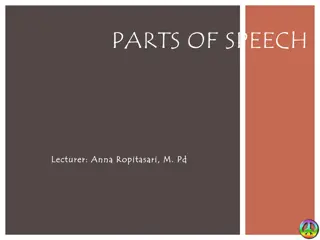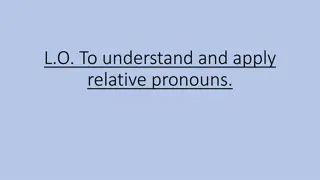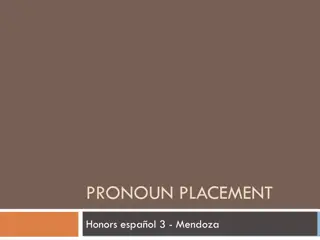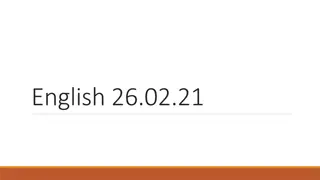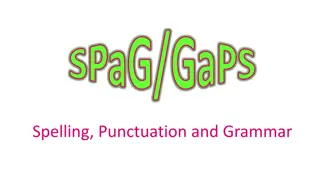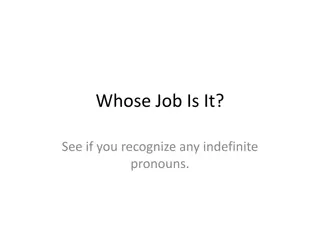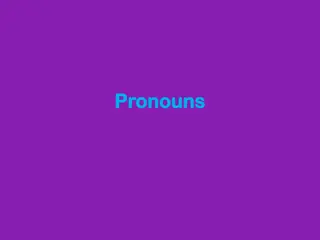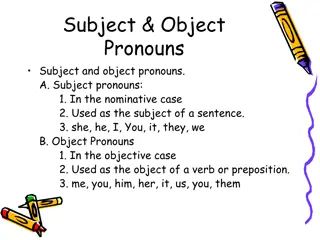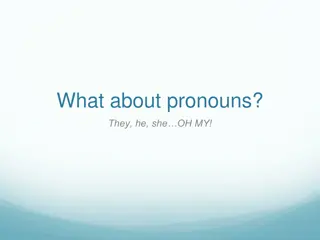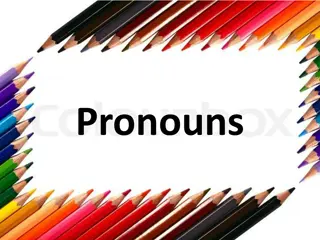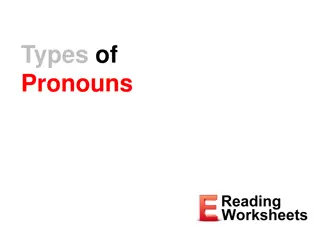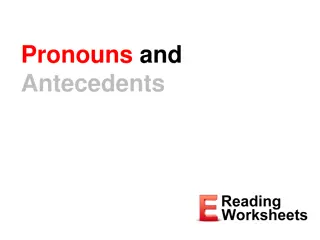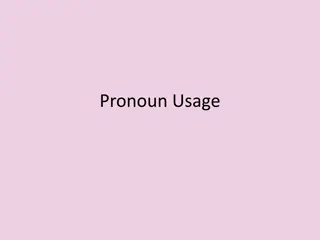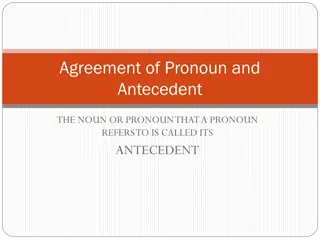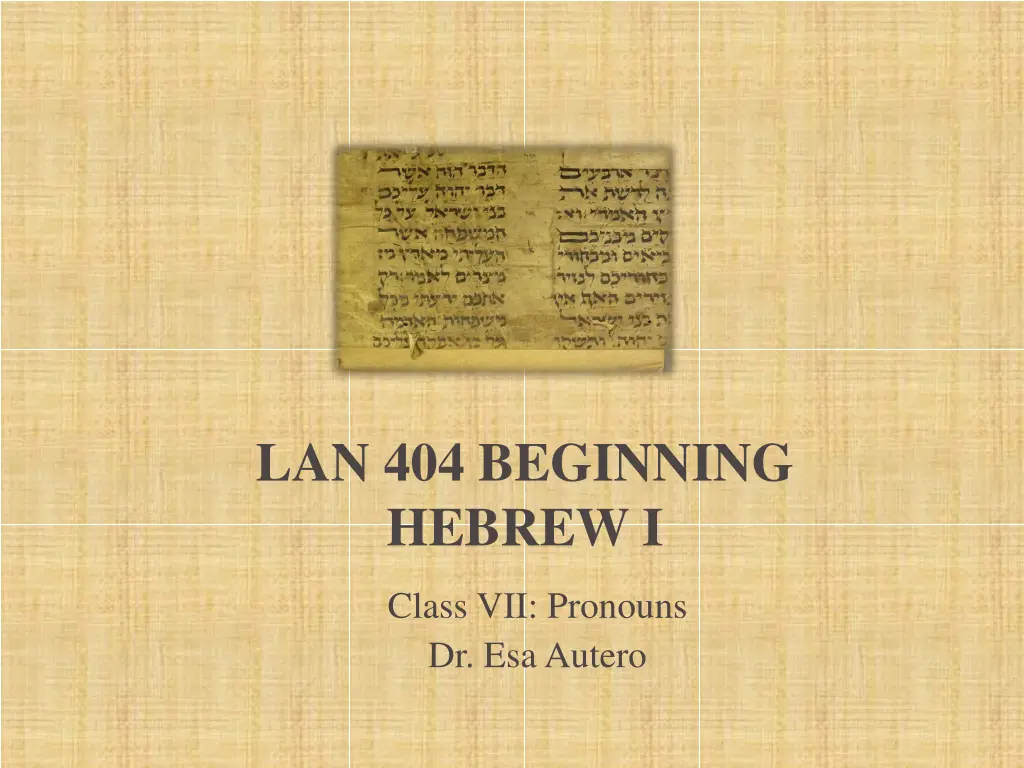
Hebrew Pronouns: Introduction and Usage Guide
Explore the essentials of Hebrew pronouns in this informative guide, covering different types of pronouns, their usage, and examples. Understand the functions of personal, demonstrative, relative, and interrogative pronouns in Hebrew language.
Download Presentation

Please find below an Image/Link to download the presentation.
The content on the website is provided AS IS for your information and personal use only. It may not be sold, licensed, or shared on other websites without obtaining consent from the author. If you encounter any issues during the download, it is possible that the publisher has removed the file from their server.
You are allowed to download the files provided on this website for personal or commercial use, subject to the condition that they are used lawfully. All files are the property of their respective owners.
The content on the website is provided AS IS for your information and personal use only. It may not be sold, licensed, or shared on other websites without obtaining consent from the author.
E N D
Presentation Transcript
LAN 404 BEGINNING HEBREW I Class VII: Pronouns Dr. Esa Autero
Pronouns 1.1 Introduction A pronoun is a word that replaces a noun Antecedent is the word(s) which the noun refers back to Moses was 120 years old when he died Moses = antecedent he is the pronoun that refers back to Moses Different types of pronouns Personal, demonstrative, relative, and interrogative pronouns Personal: I, you, he, she, we Demonstrative: this, that, these, those Relative: whose, that, which, who Interrogative: What? Who? How? Hebrew pronouns function in a similar way as English pronouns
Pronouns 2.1 Independent personal pronouns Independent stand alone, not attached to any other word 1st, 2nd, 3rdperson singular (Sg.) or plural (Pl.) Person and Number in English Sg. 1 Sg. 2 Sg. 3 Pl. 1 Pl. 2 Pl. 3 I You He/she/it We You They
Pronouns Independent personal pronoun paradigm Paradigm in Hebrew Singular , , Plural 1 com. I We 2 masc. You You , 2 fem. You You , , 3. masc. He/it They 3. fem. She/it They
Pronouns Use of the independent personal pronoun memorize words Independent pronouns in a noun sentence (predicative relationship) Personal pronoun may precede or follow the noun or adjective I am the LORD He is a righteous prophet You (sg.2.masc.) are a good king We are brothers She is a wise woman You (pl.2masc.) are in the great city
Pronouns 2.2 Demonstrative pronouns and adjectives English demonstrative pronouns this , these , that , and those used as an adjective or pronoun Adjectival usage: this man, that woman, these socks Pronominal usage: that is the man, these are the socks Increases the word s specificity beyond the definite article A A man man the the man man that that man man Hebrew demonstratives function like English equivalents
Pronouns Demonstrative paradigm Singular Plural , , Masculine This These Feminine This These Masculine That Those Feminine That Those NOTE: sg. 3 masc. and fem. demonstratives identical to personal pronouns , , Variant forms ,
Pronouns Some ambiguities sg. 3 or demonstrative? Personal pronoun or demonstrative pronoun? He is the man (personal pronoun) That is the man (demonstrative) She is the woman (personal pronoun) That is the woman (demonstrative)
Pronouns The use of demonstrative pronouns Demonstratives used as adjectives or pronouns 1) Demonstrative Adjectives follows noun: agrees w/ gender, number, definit. This man This woman That man That woman These men These women Those men Those women
Pronouns Demonstrative pronoun and adjective examples This good man This good woman Attributive adjective is placed b/w noun & demonstrative adj. It agrees in gender, number & definiteness That good man That good woman These good men These good women Those good men Those good women
Pronouns 2) Demonstrative pronouns When demonstrative functions as a pronoun, it precedes the noun Agrees in gender and number (masc./fem. & sg./pl.) not in definiteness This is the man This is the woman That is the man That is the woman These are the men These are the women Those are the men Those are the women
Pronouns 2.3 Relative pronoun English who , whom , whose , that , which Introduces a relative clause (relative pronoun + clause) Blessed in the person who studies Hebrew who studies Hebrew = relative clause that modifies the noun person Hebrew relative pronoun: That, which Who, whom When, as Does not change form or inflect
Pronouns May appear w/ or without Maqqef Follows immediately the noun it modifies The tree that (is) in the middle of the garden The mountains that (are) under the heavens The king whom you chose David, who (is) in the house of the LORD
Pronouns 2.4 The interrogative pronouns for asking questions Who, whom? , What? ] [ May appear w/ or without Maqqef Form does not change Vowel changes only in
Pronouns Interrogative pronoun examples what (is) his name? What have you done? What (is) this dream? Who (are) you? Who (is) this man? Who (are) these men?
Pronouns Interrogative particle Alternative to interrogative pronoun Prefixed to a word (Hebrew does not have questions marks etc.) The king sent the prophet Did the king send the prophet? The spelling of the changes in the following manner: Prefixed to most consonants Prefixed to gutturals or any consonant with silent Shewa Prefixed to guttural followed by Qamets
Pronouns It is possible to confuse interrogative particle w/ definite article To avoid confusion remember the following: Interrogative particle does not normally have Daghesh Forte Interrogative often prefixed to a verb or another particle The Hateph Pathach ( ) of the interrogative particle not found in definite article
Pronouns Practice Workbook p. 35, no: 1-5 p. 36, no: 1-5 Homework Workbook p. 37-38, no:1-10 Bible Translation Practice letters and reading (out loud) e.g. words on vocabulary & workbook Vocabularyquiz (Ch. 8) on words pp. 77-78 (8.12) + personal & demonstrative pronouns (p. 76-77)


